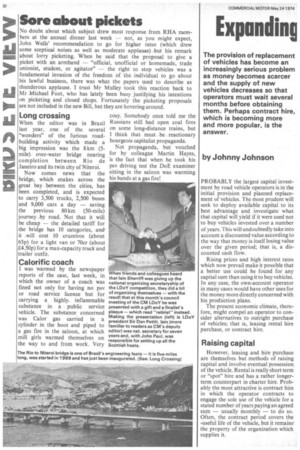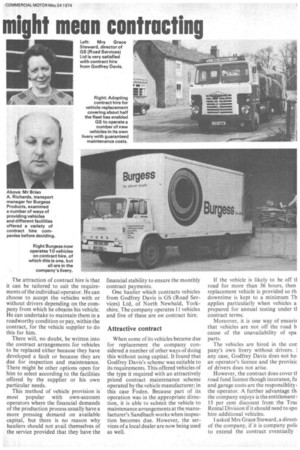Expanding might mean contracting
Page 52

Page 53

Page 54

If you've noticed an error in this article please click here to report it so we can fix it.
The provision of replacement of vehicles has become an increasingly serious problem as money becomes scarcer and the supply of new vehicles decreases so that operators must wait several months before obtaining them. Perhaps contract hire, which is becoming more and more popular, is the answer.
by Johnny Johnson
PROBABLY the largest capital investment by road vehicle operators is in the initial provision and planned replacement of vehicles. The most prudent will seek to • deploy available capital to its best advantage and investigate what, that capital will yield if it were used not to buy vehicles invested over a number of years. This will undoubtedly take into account a discounted value according to the way that money is itself losing value over the given period; that is, a discounted cash flow.
Rising prices and high interest rates which now prevail make it possible that a better use could be found for any capital sum than using it to buy vehicles. In any case, the own-account operator in many cases would have other uses for the money more directly concerned with his production plans.
The present economic climate, therefore, might compel an operator to consider alternatives to outright purchase of vehicles; that is, leasing rental hire purchase, or contract hire.
Raising capital
However, leasing and hire purchase are themselves but methods of raising capital and involve eventual possession of the vehicle. Rental is really short term or "spot" hire and has a rather longerterm counterpart in charter hire. Probably the most attractive is contract hire in which the operator contracts to engage the sole use of the vehicle for a stated number of years paying an agreed sum — usually monthly — to do so. Often, the contract period covers the -useful life of the vehicle, but it remains' the property of the organization which supplies it. The attraction of contract hire is that it can be tailored to suit the requirements of the individual operator. He can choose to accept the vehicles with or without drivers depending on the company from which he obtains his vehicle. He can undertake to maintain them in a roadworthy condition or pay, within the contract, for the vehicle supplier to do this for him.
There will, no doubt, be written into the contract arrangements for vehicles to be replaced either. because they have developed a fault or because they are due for inspection and maintenance. There might be other options open for him to select according to the facilities offered by the supplier or his own particular needs.
This method of vehicle provision is most popular with own-account operators where the financial demands of the production process usually have a more pressing demand on available capital, but there is no reason why hauliers should not avail themselves of the service provided that they have the financial stability to ensure the monthly contract payments.
One haulier which contracts vehicles from Godfrey Davis is GS (Road Services) Ltd, of North Newbald, Yorkshire. The company operates 11 vehicles and five of these are on contract hire.
Attractive contract
When some of its vehicles became due for replacement the company considered a number of other ways of doing this without using capital. It found that Godfrey Davis's scheme was suitable to its requirements. This offered vehicles of the type it required with an attractively priced contract maintenance scheme operated by the vehicle manufacturer; in this case Foden. Because part of its operation was in the appropriate direction, it is able to submit the vehicle to maintenance arrangements at the manufacturer's Sandbach works when inspection becomes due. However, the services of a local dealer are now being used as well. If the vehicle is likely to be off tl road for more than 36 hours, then replacement vehicle is provided so th. downtime is kept to a minimum Th applies particularly when vehicles a prepared for annual testing under ti contract terms.
Moreover, it is one way of ensuril that vehicles are not off the road b cause of the unavailability of spa parts.
The vehicles are hired in the con pany's own livery without drivers. any case, Godfrey Davis does not ho an operator's licence and the provisic of drivers does not arise.
However, the contract does cover ti road fund licence though insurance, fu and garage costs are the responsiblityi the operator. A further advantage th; the company enjoys is the entitlement 1 15 per cent discount from the Truc Rental Division if it should need to spo hire additional vehicles.
I asked Mrs Grace Steward, a directi of the company, if it is company poli4 to extend the contract eventually over the rest of the fleet, but it is ipparent that the present mix of part tired and part company-owned vehicles s considered to be the best for its pur)ose.
I also asked what, if any, snags had )ecome apparent during the 12 months ince the contract was completed. I was old that the arrangement has been ;minently satisfactory though care has o be taken that vehicle use was suffi:iently intensive to cover the monthly )aymeirt.
Perhaps more significant is the necesity to ensure an advantageous cash flow or the repayment is a cash debit each nonth in contract to an "on cost" debit n the case of a wholly owned vehicle.
Despite some reservation about the 16-hour replacement of vehicles, beause most of the period had elapsed beore the detention time becomes .pparent, the company feels that it is ;etting a better annual availability from he hired vehicles and there is a distinct .dvantage in knowing accurately the .nnual operating cost of each vehicle at he beginning of each financial year.
In contrast, a number of factors inluenced Burgess Products Co Ltd, of finckley to consider and eventually dopt contract hire in preference to runling its own fleet.
The company manufactures silencers fall sizes from car components to ships unnels and formerly operated 15 ehicles of various types for part of its istribution and used hauliers for the est.
After the Transport Act 1968 was lassed, it became obvious that capital iould have to be employed to meet the lore stringent maintenance requirerents and, about the same time, it was ecessary to consider replacement of the ehicles.
Future programme
Apart from the transport of its products, the company was also engaged in planning its future production programme and it was concerned with providing capital to help it develop this.
So far as transport was concerned, Burgess Products was looking for flexibility and reliability with the least possible capital outlay. To achieve this, a number of choices were examined and the final selection fell on contract hire from Eastern British Road Services Ltd.
Transport manager Brian Richards told me that the company is now operating 10 contract hire vehicles with another three contemplated. The company uses its own drivers but could have contracted to use BRS personnel had it so wished. Incidentally, BRS will undertake driver training and conversion for Burgess Products should this become necessary.
In addition, the company still owns three vehicles which are gradually being phased out, and uses hauliers services for the heavier end of its distribution.
For peak traffic flows, the company charter hires from BRS on advantageous terms. It used BRS charter hire facility when contract hire was first contemplated in order to establish the right type of vehicle for its purpose. However, BRS does go to great lengths to ensure that the vehicle which it recommends is the most suitable for the customer's operation.
Defect forms
Maintenance is undertaken in BRS workshops and, because of the nationwide service available, this can be undertaken at any workshop in the BRS net work by arrangement if it is more convenient to the operator. Brian Richards says that he feels that his operator's licence is probably safer doing this with an organization which itself has an 0 licence and knows what the Licensing Authority requires.
Besides, he argues, any possibility of maintenance not being carried out properly does not arise because the approbrium attached to poor maintenance would reflect on BRS's own licence. To augment the maintenance arrangements, the operator is able to use BRS-designated driver defect reports which are more detailed than the conventional kind.
The BRS network can also be brought in action in the event of vehicle breakdown or accident and vehicle replacement for servicing and so on can be negotiated at short notice.
Here, too, vehicle availability is enhanced so that they are kept on the road virtually 52 weeks a year and the cost of transport is determined beforehand. This means that the unit transport cost can be built in to the price of the product with accuracy.
Vehicle availability and the maintenance of a reliable service is a major factor in Burgess's decision to use contract hire. Brian Richards emphasizes the competitive nature of the company's business and points out that keeping customers supplied with Burgess products at the right time is. vital to the company's business.
These are but two of the contract hire sources available but they serve to illustrate the variety of options which are open to operators who feel that the employment of capital in providing vehicles is onerous.
Down time eliminated
Naturally, the cost of undertaking contract hire is variable according to the requirements of the operator. Bearing in mind that the organization providing the vehicles has to make a profit out of the deal, it might be considered at first sight that this is an expensive way to acquire a vehicle fleet. On the other hand, the downtime which can be incurred, for instance, in waiting for spares or through accident damage can be considerable.
It is possible that the virtual elimination of downtime and the greater availability of the vehicle in revenue earning traffic will more than compensate for the extra cost involved.
For the own-account operator, the facility of ensuring that his product is in' the right place at the right time might be a deciding factor apart from being able to predict transport costs and build them into the price of the finished product with accuracy.




































































































































